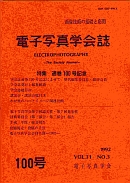Volume 36, Issue 2
Displaying 1-11 of 11 articles from this issue
- |<
- <
- 1
- >
- >|
Original Articles
-
1997Volume 36Issue 2 Pages 70-74
Published: 1997
Released on J-STAGE: April 06, 2007
Download PDF (688K) -
1997Volume 36Issue 2 Pages 75-84
Published: 1997
Released on J-STAGE: April 06, 2007
Download PDF (2513K) -
1997Volume 36Issue 2 Pages 85-90
Published: 1997
Released on J-STAGE: April 06, 2007
Download PDF (1401K) -
1997Volume 36Issue 2 Pages 91-99
Published: 1997
Released on J-STAGE: April 06, 2007
Download PDF (1437K)
Technical Review
-
1997Volume 36Issue 2 Pages 100-105
Published: 1997
Released on J-STAGE: April 06, 2007
Download PDF (1199K)
Imaging Today
“Toner Imaging Technologies”
“Toner Imaging Technologies”
-
1997Volume 36Issue 2 Pages 107-113
Published: 1997
Released on J-STAGE: April 06, 2007
Download PDF (2276K) -
1997Volume 36Issue 2 Pages 114-117
Published: 1997
Released on J-STAGE: April 06, 2007
Download PDF (1432K) -
1997Volume 36Issue 2 Pages 118-122
Published: 1997
Released on J-STAGE: April 06, 2007
Download PDF (1402K) -
1997Volume 36Issue 2 Pages 123-127
Published: 1997
Released on J-STAGE: April 06, 2007
Download PDF (1355K) -
1997Volume 36Issue 2 Pages 128-130
Published: 1997
Released on J-STAGE: April 06, 2007
Download PDF (632K) -
1997Volume 36Issue 2 Pages 131-136
Published: 1997
Released on J-STAGE: April 06, 2007
Download PDF (985K)
- |<
- <
- 1
- >
- >|
